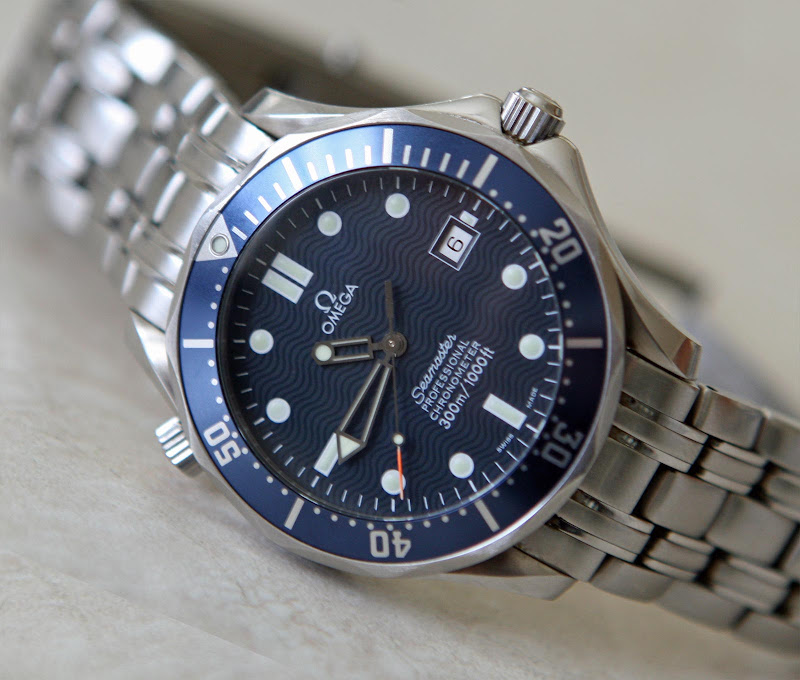You're messing with....
Hey, what do I know....
Okay now, a couple of things.... That may not make you happy...
...it doesn't! Why would I be? I spent ~ $4,800 on a watch that I've had to move forward a minute twice since I bought it!
My cheaper TAG-Heuer 4000, which I paid ~ $1,450 in 1996 is prefect (repeat P E R F E C T) and its last service was over two-and-a-half years ago. The only times I move the hands on my TAG is once per six months when the clocks either Spring Forward or Fall Backwards an hour.
And the 14060M is now COSC as you have noted...mine has 4 lines of text above the six o'clock marker, for example.
How do I wear it? Not 24/7. I'd say from 6:45 on weekday mornings to about 8pm and less so on weekends. It sits face up when its off on my bedside table where the temperature is 'average', 'comfortable' room temperature.
I jog about 29 to 32 minutes every second to third day with it on and use the rotating diving bezel to see how long it's taken me to get to various points along my route. So it does take some pounding but so did my TAG.
I'm dissapointed because I need precision (especially for certain things to do with work) and don't like taking time off to visit a dealer to have things of perceived quality fixed.
Also including some feedback from VM here before answering further.
You're messing with my mind, Hildebrand.
Hey, what do I know...I'm just a sucker who paid around five grand for a Rolex Submariner 14060M from an authorized dealer on April 3rd [just over a month ago] and the ![[censored]](https://debrief.commanderbond.net/topic/44497-watches-james-bond-watches/style_emoticons/default/censored.gif) ing thing's losing time! ...
ing thing's losing time! ...
I ask every Rolex-wearing customer who walks into my store;"Hey, how's your Rolex running?"
Half of them say it's the best watch they've ever had and the other half say it's never kept good time from day one. Hildebrand, get this watch of your over to Rolex and let them regulate it to its proper specs. They might argue that, being a 14060 model, it's not COSC rated and may therefore lose or gain more than a Chronometer rated model. Hang on. I just re-read your post. A minute every two weeks? That equates to approx, what, five or six seconds a day? I hate to say it HR, but that's within spec for a 14060. Still, Rolex should be willing to adjust it for you, even if they get the watch running fast rather than slow, because this would be preferable. Another option is to try placing the watch down in different positions every night to determine which position causes the least amount of fluctuation in time-keeping.
It's still a helluva watch, Hildebrand R.
Before going on, I want to let HildebrandRarety that I responded to your Rolex Sub concerns in another Thread where I felt it better fit....
Return the watch for a refund; this Rolex is not for you.My hope is that you will take that advice in the spirit of friendship, taking into account the lengthy and numerous private messages we've exchanged on this watch a month or so ago. When watch guys use the word "precision" in connection w/ a "chronometer," the standard is average daily variation in rate of between -4 and +6 seconds per day, measured over 15 days in the five common wrist positions and exposed to three different temperatures. Your watch appears to be w/in those specifications and meeting the highest standards attainable for a piece w/ a mechanical movement. If it were outside of that, we'd be having a different discussion. In fact, I returned a calibre 1120 movement Omega Seamaster, exchanging it for another of the same model, because it was losing 5 seconds per day, consistently.
But when you use the word "precision" outside of chronometers, and, indeed, in referring to the work place, this watch can't do that. Even Omega, which is the official timekeeper of the Olympics, doesn't use mechanicals for that job. Think about a quartz watch, which typically varies between -0.5 seconds per day and +0.7 seconds per day. And digital models are better than analog.
Your TAG experience is irrelevant. My son got a Pirates of the Caribean watch
free w/ a Mighty Kids Meal from McDonalds the other week, and that watch is more accurate than my Rolex Submariner 14060M. Add water resistance and shock capabilities, and maybe you're talking a $500 watch.
Now, if you want to get a bit into understanding how your watch might be manipulated short of having it re-regulating (which I'm not in favor of, as I'll explain below), here are some thoughts. First, if you watch the second-hand for one minute while listening to time-tones on your phone from something like the
US Naval Observatory Master Clock, you may notice that your chronometer can vary by as much as half-a-second in disagreement w/ the Master Clock, depending on whether or not that hand is sweeping "down" (ie, from the 12 o'clock to 6 o'clock position), or "up" (ie, from the 6 o'clock to the 12 o'clock position). I have found this to be true on both my Omega and Rolex models. Another indication of the world in which you're living when you wear a chronometer.
Assuming your watch was fully wound when you started wearing it, your weekday pattern sounds okay to keep it powered. But I'm not sure what "less" on the weekends means; you may need to wind it on those days. Your watch seems to live in two different temperature environments, which can vary significantly between wrist and nightstand. Again, speaking to my own 14060M, it runs differently when I wear it on a bracelet (caseback in contact w/ my wrist) versus on a NATO strap (w/ one layer of the strap separating the caseback from my wrist). Like I said, "temperature" is a variable that COSC recognizes. You might then try wearing it for longer periods of time, including on the weekends.
Your jogging shouldn't make a difference.
In terms of off-wrist position, remember: COSC considers there to be five.
- Face up
- Face down
- Crown up (on its edge)
- Crown down (on its edge)
- 12 o'clock down (on its edge)
You consistently rest your watch in one. You'll probably see some difference if you experiment w/ other positions (and not necessarily just the opposite of what you're doing now).
VM is correct about having the watch re-regulated: It's a very simple thing to do. But I'd
only have that done by Rolex, of which there are only three official locations here in the U.S. (the closed to you and me is New York; not sure about your neck of the woods). I'm really particular about dust getting into my mechanisms, and, of course, there is the issue of having your watch pressure tested after the work is done to ensure it's been re-sealed properly. To be frank, re-regulation would not be my first choice here.











